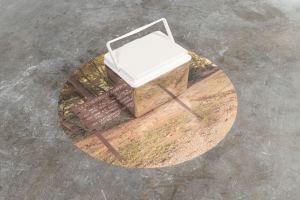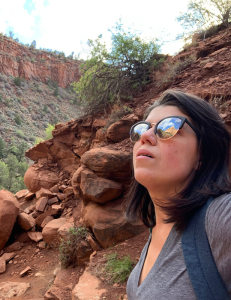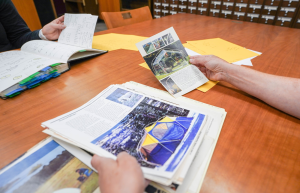FSU Art Professor, MoFA Curator brings great outdoors into the arts Five questions with Meredith Lynn
By: Rory Donohue

Arches National Park (Devil’s Garden), Inkjet on silk, tent hardware, rocks, video projection, Dimensions variable (about 9’x9’ footprint including stakes, 10’ wall for decal), 2020. Pictured at UMOCA.
FSU Department of Art Assistant Professor and Museum of Fine Arts Curator Meredith Lynn shares her recent research and work with the CFA, including a project with The North Face!
Lynn’s art has been featured at museums and galleries across the country and she has served as an artist in residence at institutions including the Crisp-Ellert Art Museum in St. Augustine, FL, Jentel Foundation in Sheridan, WY and Signal Fire in Portland, OR.
Her current work focuses on nature in the modern age and questions our relationship to land ownership, climate change and the purpose of imagery.
Currently, Lynn’s work is being showcased by the Utah Museum of Contemporary Art in their exhibit A Greater Utah. She was recently featured in Burnaway, a contemporary art publication.
We sat down with Meredith to ask her some questions about her life and work and discuss some of her upcoming adventures.
What is the first step in your artistic process?
I think most artists have some sort of process of inquiry that they go through. For some people it might be based in materials, or maybe you’re out on a walk and inspiration strikes. For me, it’s actually much more research based. A lot of the work that I do relates to history; histories of places, design, materials. Now, my work is project-based and takes a couple of years. I am usually in the middle of something, and then I see something that will lead to the next step. For me, rarely does anything have a beginning or an end, it’s all part of the same trajectory.
For the past several years, my collaborator Katie Hargrave and I have been thinking about how people interact with the outdoors and how our interactions are mediated through many different systems. One system that impacts that is the development and management of public land. When you go to a national park there are roads through it and signs that tell you “this is what you should look at.” Another way is through outdoor recreation products like tents and backpacks. The past several years Katie and I have been manipulating these products.
You recently visited the Outdoor Archive at Utah State University. What was that opportunity like?
In 2020, we visited the five national parks in Utah and did an intervention at each park. For Arches National Park, we found photographs that tourists had taken, printed those photographs on silk, and then sewed a tent with that silk, and then set the tent up at the only developed campsite and photographed it there. The piece is on view at the Utah Museum of Contemporary Art right now.
This June, we were invited to Utah State as research fellows where we spent a week researching a project about the North Face’s first geodesic dome tent. We’ll be creating our own version of that tent and then bringing it to the locations where the North Face photographed it in the ‘70s for its catalogs: the Lassen Volcanic National Park in California and the tallest mountain in Bolivia. We’re going to have to get some more mountain climbing skills, because the mountain is twenty-one thousand feet.
Do you find it difficult to bring your idea of the outdoors into the gallery?
The work I make is very object-based. It’s interesting to see how the object changes when it’s in the landscape versus the gallery. We will make a tent and outdoors it will seem small, but we bring it to a museum or a gallery and it’s actually huge.
When we set up the tent at Arches, people came up to us saying, ‘that’s a really cool tent. Where could I buy that tent?’ And we replied, ‘Oh, you can’t, this is an art object.’ When it’s in that context, it reads as a tent, but when you put it in the gallery, it becomes a sculpture. I think we’re always aware when developing these things that they’re going to have these two different lives, but it is really interesting to see that shift happen.
How does your work as a curator at the MoFA influence your artwork?
As a curator, a lot of my projects are about the environment and about climate change. My biggest curatorial projects, like Rising Water and Boundless Terrain, definitely relate to my artistic practice and those ideas about nature and the relationships that we have to landscape and to the outdoors. These are ideas that I return to both as a curator and an artist. My work as a curator is more rooted in issues of justice around and the cultural impacts of climate change, but it is all part of the same ethic.
As a professor, I mostly teach graduate students in the department of art. I see a lot of connections between all the things that I do here at Florida State. But I’m always happy when these things diverge, because it makes my job more interesting. I never really spend too much time on any one thing, I’m always hopping around and doing different kinds of work.
What piece of advice do you have for young artists?
“You need to create the world that you want to live in,”
Meredith Lynn, Professor of Art & MoFA Curator
I always like to tell students that you don’t need to wait for someone to give you the opportunity that you want, that you can make it yourself. You need to create the world that you want to live in, don’t wait for an institution to recognize you. Go out and do it on your own, but that also means that you have to work hard and be patient. Work hard, be patient, be nice, say please and thank you. That’s my first piece of advice; say please and thank you.



